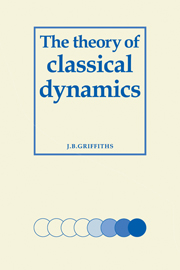Book contents
- Frontmatter
- Contents
- Prefaces
- Introduction
- 1 The Newtonian method
- 2 Space, time and vector notation
- 3 Force, mass and the law of motion
- 4 Newtonian relativity
- 5 Newtonian gravitation
- 6 Particle dynamics
- 7 Systems of several particles
- 8 Rigid body dynamics
- 9 Analytical dynamics
- 10 Variational principles
- 11 Hamilton–Jacobi theory
- Appendix list of basic results and definitions
- Suggestions for further reading
- Index
3 - Force, mass and the law of motion
Published online by Cambridge University Press: 25 October 2011
- Frontmatter
- Contents
- Prefaces
- Introduction
- 1 The Newtonian method
- 2 Space, time and vector notation
- 3 Force, mass and the law of motion
- 4 Newtonian relativity
- 5 Newtonian gravitation
- 6 Particle dynamics
- 7 Systems of several particles
- 8 Rigid body dynamics
- 9 Analytical dynamics
- 10 Variational principles
- 11 Hamilton–Jacobi theory
- Appendix list of basic results and definitions
- Suggestions for further reading
- Index
Summary
We come now to consider the more familiar subject matter of the theory of classical dynamics as we turn to the concepts of force and mass, and the way in which such concepts are used to analyse and predict the motion of a physical body. However, it is necessary first to introduce the concept of a particle.
The concept of a particle
In classical dynamics we consider the motion of real physical objects. These are sometimes referred to as bodies. The aim is to develop a method whereby the motion of such bodies can not only be analysed, but also predicted. Unfortunately, the physical bodies whose motions are to be considered are usually fairly complex objects. It is therefore necessary to start by making some simplifying assumptions about such bodies in order that they may easily be represented in a theoretical model.
In some circumstances it turns out to be comparatively simple to build a theoretical representation of physical bodies. For example, when a stone is thrown into the air, or when considering the motion of a planet in the solar system, the main interest is usually in the general position and velocity of the object, or its general linear motion, rather than its orientation and angular motion. In such situations the information given or required about its motion can usually be stated in terms of the position at different times of some representative point of the body, such as some kind of centre.
- Type
- Chapter
- Information
- The Theory of Classical Dynamics , pp. 35 - 66Publisher: Cambridge University PressPrint publication year: 1985

